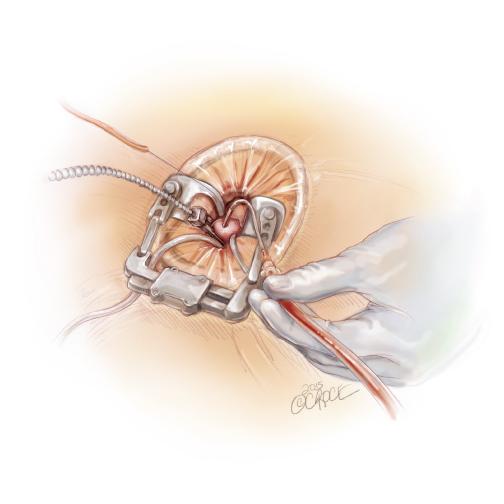Aortic Stenosis
Background
Aortic stenosis is the narrowing of the heart’s aortic valve. The aortic valve normally opens with each contraction of the heart to allow blood to pass from the heart to the aorta and rest of the body. Narrowing of this valve obstructs blood flow from the heart and to compensate, the heart needs to work harder in order to pump enough blood to the body. If left untreated, progression of this condition may weaken the heart over time and result in a number of life-threatening complications, including heart failure, abnormal heart rhythms and cardiac arrest. Appropriate treatment and monitoring is essential to prevent these complications from occurring and to ensure a good quality of life for those affected.
Causes
The most common cause of aortic stenosis is the accumulation of calcium deposits on the aortic valve, which increases with age. This causes the aortic valve to stiffen and narrow over time. This results from an active inflammatory process and is associated with risk factors for coronary artery disease, such as high cholesterol, diabetes and smoking. Aortic stenosis may also be caused by a congenital abnormality of the aortic valve. Compared to a normal aortic valve comprising three cusps, a valve with two cusps, also known as a bicuspid valve, may cause narrowing due to the structural abnormality and the increased risk of calcium build-up. Less common causes include scarring from rheumatic heart disease and infections affecting the valve.
Signs and Symptoms
Patients with mild aortic stenosis may not present with any significant symptoms and the valve defect may only be suggested by detection of an abnormal heart murmur when undergoing a physical examination. In more severe cases, patients may suffer from chest pain, fatigue, palpitations, shortness of breath and fainting, especially with exertion. Difficulty in adapting to the increased workload on the heart may lead to heart failure, characterized by worsening fatigue, shortness of breath and ankle swelling.
Management
For patients with mild aortic stenosis and with no symptoms, regular monitoring by imaging is appropriate. The only definitive therapy for the condition is replacement of the defective aortic valve. Aortic valve replacement has traditionally been carried out by open-heart surgery, where the cardiac surgeon removes the defective valve and replaces it with a mechanical or tissue valve. This is now commonly performed by a minimally invasive incision through the chest wall. For patients with a high risk of complications from this approach, there is an alternative procedure known as a transcatheter aortic valve implantation (TAVI). This involves insertion of a catheter with a balloon and folded prosthetic valve at its tip into an artery in the leg or apex of the heart. This is then guided to the aortic valve and the prosthetic valve is opened and positioned by inflation of the balloon. In addition to these procedures, medications may be prescribed to relieve associated symptoms. For more information, please visit the following websites:
http://www.mayoclinic.org/diseases-conditions/aorticstenosis/basics/treatment/con-20026329
http://emedicine.medscape.com/article/150638-overview
http://www.clevelandclinicmeded.com/medicalpubs/diseasemanagement/cardiology/aortic-valve-disease/

Services
Cardiac Surgery
- Aortic Arch Surgery
- Aortic Stenosis
- Aortic Surgery and Stroke
- Aortic Valve Repair
- Coronary Artery Bypass Grafting
- Heart Failure
- Tissue and Mechanical Heart Valves
- Type B Aortic Dissection
- Ventricular Assist Devices
- Hybrid Aortic Arch Surgery
- Marfan Syndrome
- Minimally Invasive Aortic Valve Replacement
- Minimally Invasive Atrial Fibrillation Surgery
- Minimally Invasive Mitral Valve Surgery 2015
